Cliff Walks
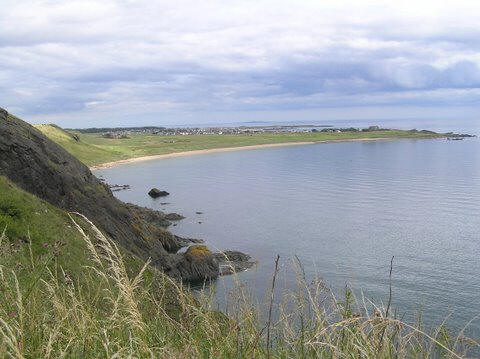
West Bay with the village in the
background.
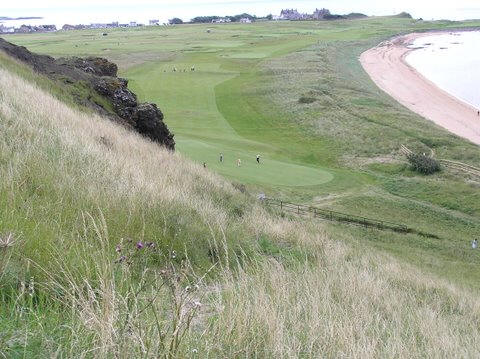
The Croupie Rock with the 13th.
green below.
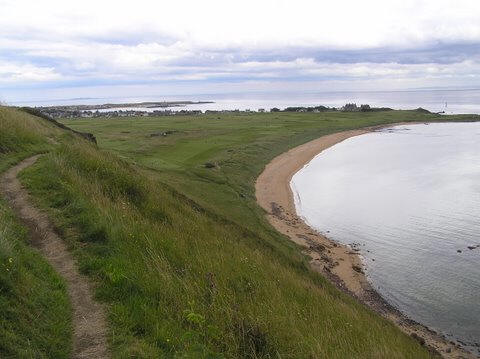
For many years my feet helped to
make this pathway
The 200
foot high cliffs at Kincraig begin at the west end of
Earlsferry's West Bay. The cliffs provide two
spectacular walks. One, quite close to the edge, goes along
the top of the cliffs. The other goes around the base of
the cliffs.
The
upper walk starts by a pathway that leads upwards from the
14th tee on the golf course. On the way up the
path goes by the Croupie Rock and ends at Shell Bay. On top
of the Croupie Rock was one of my favourite vantage points
to lay and watch the movement of all the many ships that
plied the waters of the Firth of Forth, including the might
and power of the British Navy. Along the way wild flowers
of many, many kinds grow in profusion including bluebells
and cowslips.
During WW2 in anticipation of whatever
invasion plans that Hitler might have had our
military fortified the cliffs at Earlsferry by installing
three large caliber naval guns at the highest vantage point.
Lookout observation posts were built into the side of the
cliffs and were manned 24 hours a day by the 258th
Battery, 505 Coastal Regiment. At several locations on
the cliffs and the golf course, high powered searchlights
and anti aircraft guns were installed.
Atop the
cliffs stood Kincraig Mansion House, the seat of the Gourlays. Gourlays have been in possession of and lived at
Kincraig for well over 600 years. The first of the family
came to Kincraig during the reign of King William the Lion.
It was a sad day when wreckers arrived, demolished the house
then cleared the site.
From the
top of the cliffs and on a clear day the 360 degree views
are breathtaking. Over the villages of Earlsferry and Elie
one sees Elie Harbour, Elie Lighthouse, the Lady's Tower,
and the coastline villages of the East Neuk of Fife and the
May Island. To the south and across the Firth of Forth is
Dunbar, North Berwick, the Bass Rock and Fidra Island,
thence further west along the south coastline is Leith,
Edinburgh with its castle and Arthur's Seat.
Continuing on the eye sees the Lomond Hills, Largo Law,
Largo, Largo Bay, Ruddons Point, and Shell Bay. Largo is the home
of Alexander Selkirk. Daniel Defoe using the
experiences ofAlexander Selkirk as his inspiration wrote his
famous book of fiction,Robinson Crusoe. It's also accepted that Robert Louis Stevenson used the
experiences of Alexander Selkirk to write his well known
book, Treasure Island.
When the
tide is out an exciting walk for the intrepid is to go
around the base of the cliffs by way of the chain walk. Foot steps are cut into the rock and a series of chains
help one to hang on in order to traverse the ups and downs
of the route. It's an exciting and interesting scramble.
Along the way seagulls and a great variety of seabird
species can be seen close up as they glide on the thermals
to land on the inaccessible ledges where they have their
nests.
For the geologist the variety of rock types and formations are a gourmet feast.
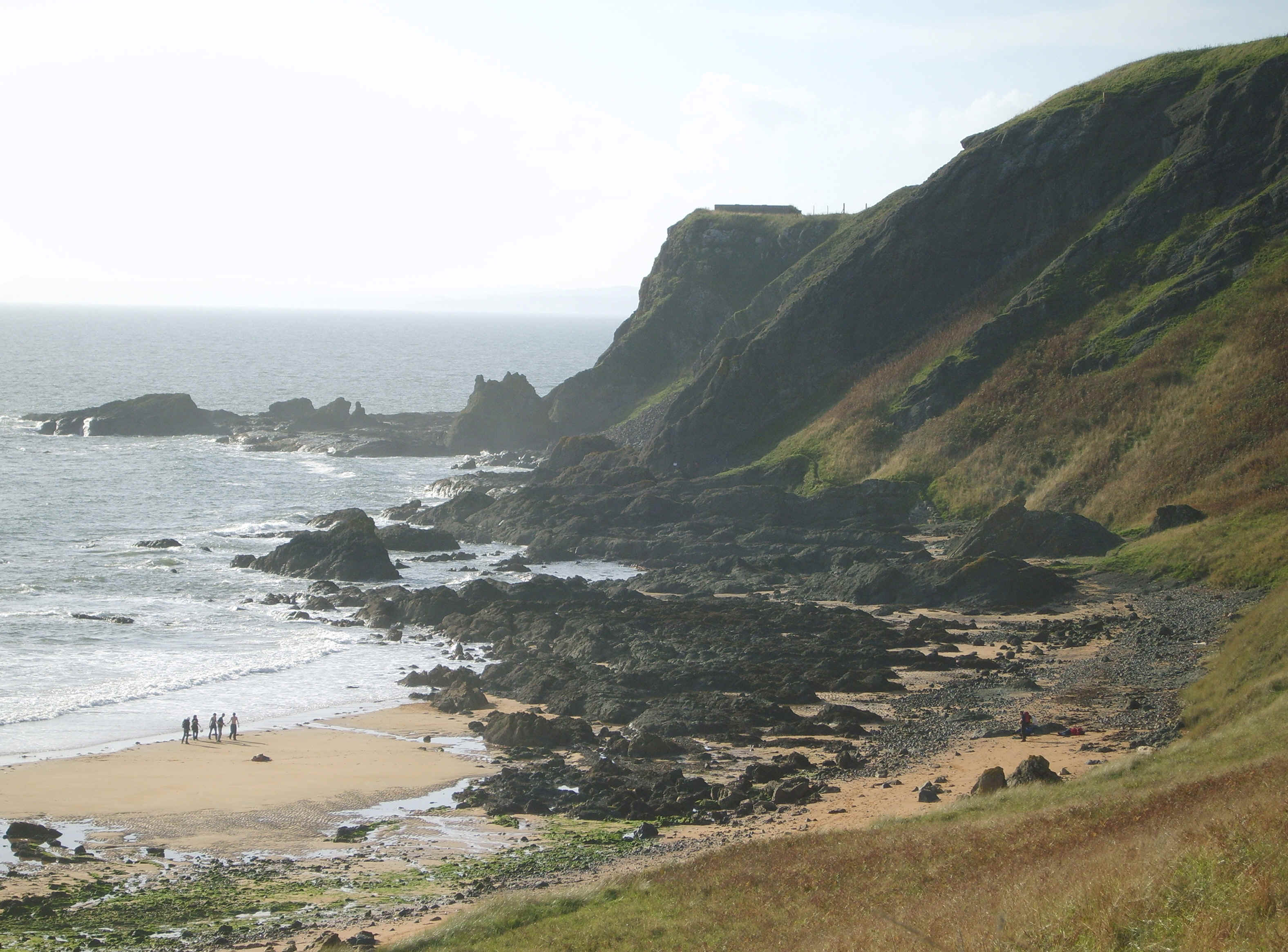
The path goes between the rock in
the grass at the right center and the larger rock to it's
left.
Up on the west facing side of
the larger rock is Chairlie's Chair.
Starting
the walk from the Earlsferry end and at the west end of West
Bay the first point of interest
is the Stickleback Dub, a pool of brackish water that's home
to a colony of sticklebacks. The dub is about half rain
water and half sea water. The dub is above the high tide
mark but at the full of the moon a few waves from the
highest of the tides manage to spill over the rocks to keep
the dub filled with salty water. Sticklebacks are interesting
little fish in that they can live in either fresh or salt
water. Males build and attach nests to the
seaweed in the pool then change color to blue and
red to attract the females who deposit eggs into the nests.
Immediately next is an outcropping of rock that on its upper level is
"Chairlie's Chair", a natural
weather carved throne. Those who scramble up to sit on
the throne acquire lifelong membership into "The Ancient
Order of the Ferry."
Further along is Macduff's
Cave, where tradition has it that Macduff, the Thane of
Fife, when fleeing from Macbeth hid in the cave while at
Earlsferry, a boat was being readied for him to make his
escape across to the south side of the Firth of Forth.
Supposedly this is how and when Earlsferry acquired its name.
Next is
an interesting small bay named, the Stottin Stanes. Here
the shoreline at the base of the cliffs is covered with sea
rounded and polished stanes that rumble as each
wavelet washes them to and fro. This shifting of the
stanes writes the sea's symphony as each wavelet creates an
ever changing melodious rumbling.
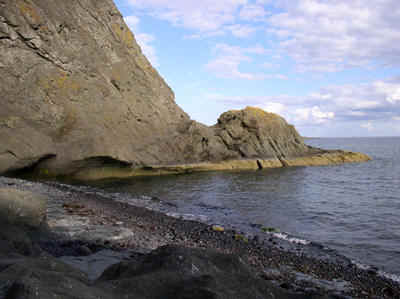
The Stottin Stanes
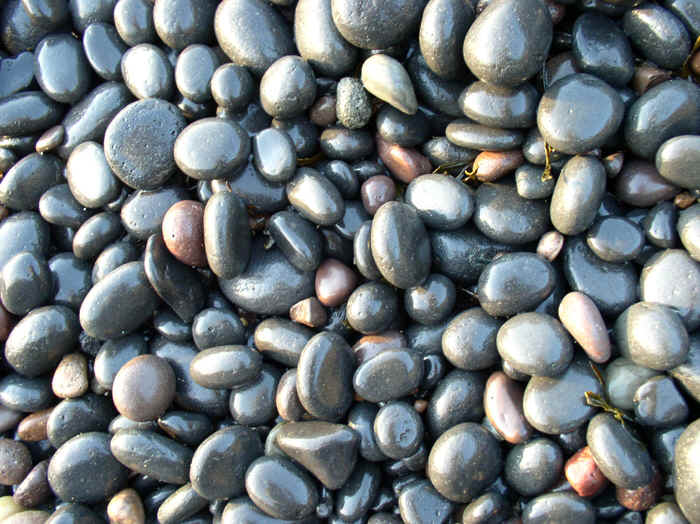
Next
comes some interesting columnar vertically upthrust rock .
If you're a geologist this formation will give you much to
conjecture. Next is a
relatively level place of volcanic trap that's composed of black basalt called the
Flairs that ends abruptly at the seas edge. If you're a fisherman the Flairs is a
great place to sit on the edge of the rocks as you cast a
baited hook into the sea. In my days of fishing there I've
caught many fine codlings and good sized flounders. While thus
engaged I've seen big salmon swim by within a few feet of
me.
Next are two more caves, the Doos Cave
and the Deil's Cave. The Doos, so named for the great
number of cushie doos (pigeons) that claim this cave as
their home. Did the devil live in the Deils? At high tide
the sea washes into these caves.
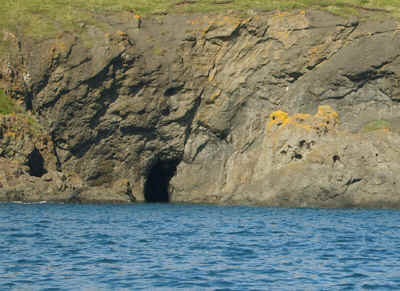
The
Deil's Cave
It takes several minutes
for the eyes to adjust as one explores the inner depths of
the caves. There
are stories of old that these caves were used by smugglers. There
was also the story that at one time the caves were connected
by tunnels that led up to Kincraig House that sat on top of
the cliffs.
Near the west end of the cliff walk is a very interesting
large chunk of red granite, a one of a kind red object that is sitting in an
area that is composed entirely of black rock. Maybe more
than a million years ago this boulder was dropped from
an ice-age glacier that melted and deposited it there at the
time when ice covered and flowed over the land. Now by being
continuously chipped away by people to get pieces as curiosities the
boulder's size today is less than half what it was than when
I was a boy. In a few years at the present rate that it's
being diminished it will no longer exist.
The
walk ends at a series of ancient tiered (raised) beaches.
One day my friend
Jems, Jimmy Linton,
and I climbed the cliffs from
the bottom to the top. Jems was ahead of me and made
it to the top without incident. As I neared the top I got stuck on a
sloping, narrow and crumbling ledge. With both
hands I was hanging on to the rocks above me and I couldn't
move my one foot past the other. For the longest time I could move neither forward
nor backward, nor down nor up. One false move and it was down, straight
down. Had I slipped it would have been curtains. Such are
the lives of boys.